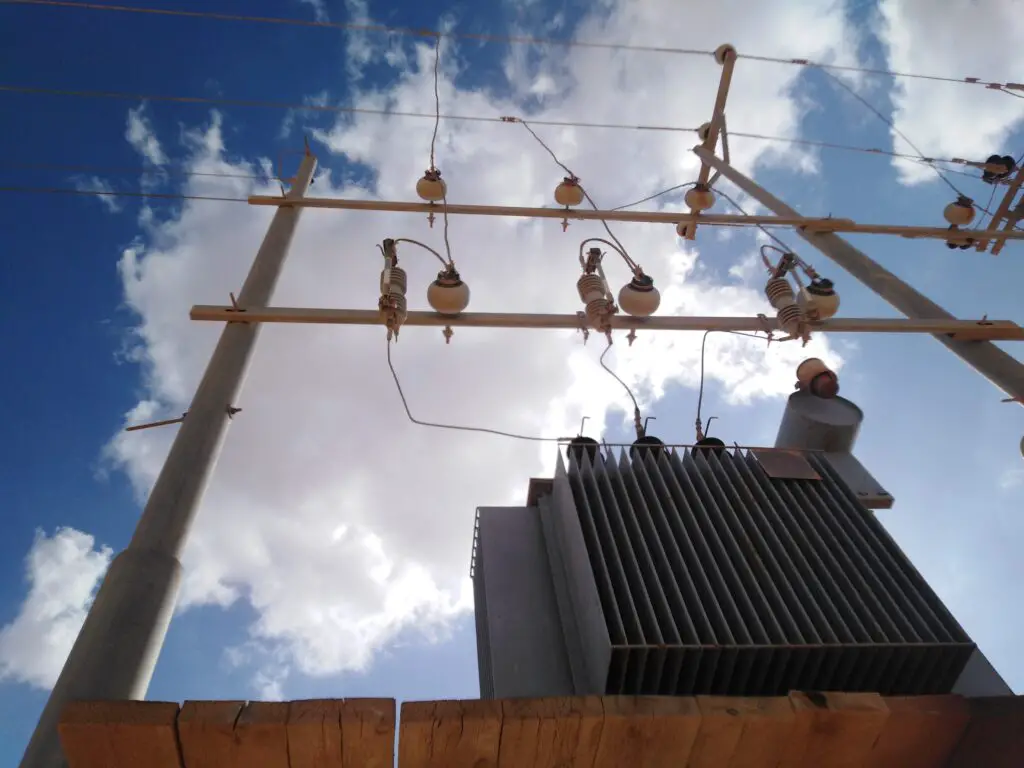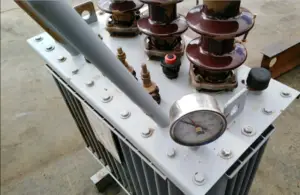Table of Contents
What is transformer efficiency?
Electric transformer efficiency is a measure of how effectively a transformer converts electrical power from one voltage level to another.
Transformers are essential devices in electrical power systems for voltage regulation, distribution, and transmission. They work based on the principle of electromagnetic induction.
The efficiency (ηη) of an electric transformer is defined as the ratio of output power to input power, expressed as a percentage:
η=(Output PowerInput Power)×100%
In mathematical terms:
η=(Vout×IoutVin×Iin)×100%
Where:
- V-in is the input voltage.
- I-in is the input current.
- V-out is the output voltage.
- I-out is the output current.
In an ideal transformer with perfect materials and no losses, the efficiency would be 100%. However, real-world transformers experience some losses due to factors such as resistive losses in the windings, hysteresis losses in the core material, and eddy current losses.
These losses contribute to a reduction in the overall efficiency of the transformer.
Efficiency is an important factor to consider in power systems, as higher-efficiency transformers lead to less wasted energy, reduced heating, and better overall performance.
Transformer efficiency is often specified by manufacturers and is an important parameter for selecting transformers for specific applications.
How to increase the efficiency of the transformer?

Increasing the efficiency of a transformer involves minimizing losses and optimizing its performance under various operating conditions.
Transformers can experience different types of losses, including resistive losses in the windings, core losses, and stray losses. Here are some ways to enhance the efficiency of a transformer:
- Choose a Higher Efficiency Transformer:
- When selecting a transformer, opt for one with a higher efficiency rating. Transformer efficiency is often provided by manufacturers, and choosing a more efficient model can lead to energy savings.
- Operate at or Near Rated Load:
- Transformers are designed to operate most efficiently at or near their rated load. Operating a transformer close to its rated load minimizes proportional losses and improves overall efficiency.
- Load Management:
- Avoid operating transformers significantly below or above their rated loads. Transformers can experience higher losses when operating at loads outside their designed range.
- Use Energy-Efficient Materials:
- Employ high-quality materials in the construction of transformers. This includes using conductors with low resistivity and core materials with low hysteresis and eddy current losses.
- Optimize Cooling Systems:
- Ensure effective cooling of the transformer. Proper cooling helps maintain the temperature within acceptable limits, minimizing resistive losses in the windings and improving overall efficiency.
- Reduce Core Losses:
- Choose transformer cores with low magnetic hysteresis and eddy current losses. High-quality core materials and advanced core designs can help minimize these losses.
- Use Step-Up/Step-Down Transformers Strategically:
- Employ transformers in a way that minimizes the need for voltage conversion. Operating at higher voltages reduces current, and lower current results in lower resistive losses.
- Implement Load Tap Changers (LTC):
- Load tap changers allow for adjusting the turns ratio of the transformer to optimize voltage regulation. This can enhance efficiency under varying load conditions.
- Monitor and Maintain Transformers:
- Regularly monitor the performance of transformers and conduct maintenance to ensure they are operating optimally. Address any issues promptly to prevent efficiency degradation.
- Consider Energy-Efficient Designs:
- Explore newer transformer designs and technologies that incorporate advanced materials and construction techniques to improve efficiency.
It’s important to note that the effectiveness of these measures can depend on the specific characteristics of the transformer, the application, and the operating conditions.
Consulting with transformer manufacturers and electrical engineers can help in making informed decisions to increase transformer efficiency.
Are Transformers more efficient when cooled?
Yes, cooling plays a significant role in improving the efficiency and performance of transformers. Transformers can experience heating due to various factors, including resistive losses in the windings, core losses, and stray losses.
If the temperature of the transformer rises excessively, it can lead to reduced efficiency, accelerated aging, and potential damage to the insulation.
Cooling methods are employed to manage the temperature of transformers and ensure their optimal performance. There are two main types of cooling methods used for transformers:
- Dry-Type Transformers: These transformers rely on natural convection or forced air circulation for cooling. They don’t use liquid cooling agents. The efficiency of dry-type transformers can benefit from proper ventilation and cooling systems.
- Liquid-Immersed Transformers: These transformers are immersed in a cooling liquid (usually oil). The liquid absorbs the heat generated during operation, and cooling systems, such as radiators or heat exchangers, are used to dissipate the heat from the liquid. Liquid cooling is generally more effective than air cooling.
Ways Cooling Improves Efficiency:
- Temperature Reduction: Cooling helps maintain the transformer’s operating temperature within acceptable limits. Cooler temperatures reduce resistive losses in the windings and improve the overall efficiency of the transformer.
- Reduced Aging: Excessive heat can accelerate the aging process of insulation materials in transformers. Proper cooling helps extend the lifespan of the transformer.
- Improved Dielectric Strength: Cooling helps maintain the dielectric strength of the insulating materials, ensuring the insulation properties remain effective.
- Thermal Expansion Control: Transformers go through thermal expansion and contraction during operation and cooling. Proper cooling helps manage these thermal variations and prevents mechanical stresses that could affect the transformer’s structural integrity.
- Stability: Cooling contributes to the stability of the transformer’s electrical and mechanical components, preventing overheating-related issues.
In summary, effective cooling is crucial for maintaining the efficiency and reliability of transformers by controlling temperature and minimizing losses.
The choice of cooling method depends on factors such as the transformer’s size, application, and environmental conditions.
How does transformer efficiency vary with load?
Transformer efficiency is not constant but varies with the load on the transformer. The efficiency of a transformer is influenced by factors such as resistive losses, core losses, and other losses, which can change at different load levels.
Generally, transformer efficiency is highest at or near its rated load and tends to decrease as the load deviates from this point.
- Near Rated Load:
- At or close to the rated load, transformers are designed to operate most efficiently. This is because they are typically sized and optimized for specific load conditions.
- Resistive losses are minimized, and the transformer operates closer to its peak efficiency point.
- Below Rated Load:
- When the load is below the rated value, the transformer may experience higher proportional losses relative to the power being transferred.
- Operating at a lower load can lead to higher percentage losses, particularly in the form of copper losses in the windings.
- Above Rated Load:
- Operating a transformer above its rated load can also reduce efficiency. This is because the transformer may not be designed to handle higher loads efficiently, and losses may increase disproportionately.
- Idle or No Load:
- Transformers still consume some power even when there is no load connected (idle condition). This is due to core losses, which include hysteresis and eddy current losses.
- The efficiency at no load is generally lower compared to the efficiency at rated load.
Don’t Leave Empty-Handed!
Install my Free Android App on Google Play:
Electrical Cables Most Common Tables “Cables Tables”
And, my Electrical Calculations App “Fast Electrical Calculator”
Discover more great content by subscribing to My channel
Looking to stay ahead of the game in the world of electrical engineering? Subscribe to my YouTube channel and gain access to exclusive content you won’t find anywhere else!
The staff I recommend
(Amazon Affiliate Links to products I believe are high quality):
- Economy 120 Volt/60Hz AC Power Source – Step-Down Voltage & Frequency Converters 1800W
- UNI-T Digital Multimeter Tester UT139C
- 50-Amp Extension Cord for RV “100ft”
- Voltage Stabilizer 110/220v
- Hair Dryer “best selling“
- TOSHIBA EM131A5C-BS Countertop Microwave Ovens
Disclaimer: This contains affiliate links to Amazon products. I may earn a commission for purchases made through these links.


